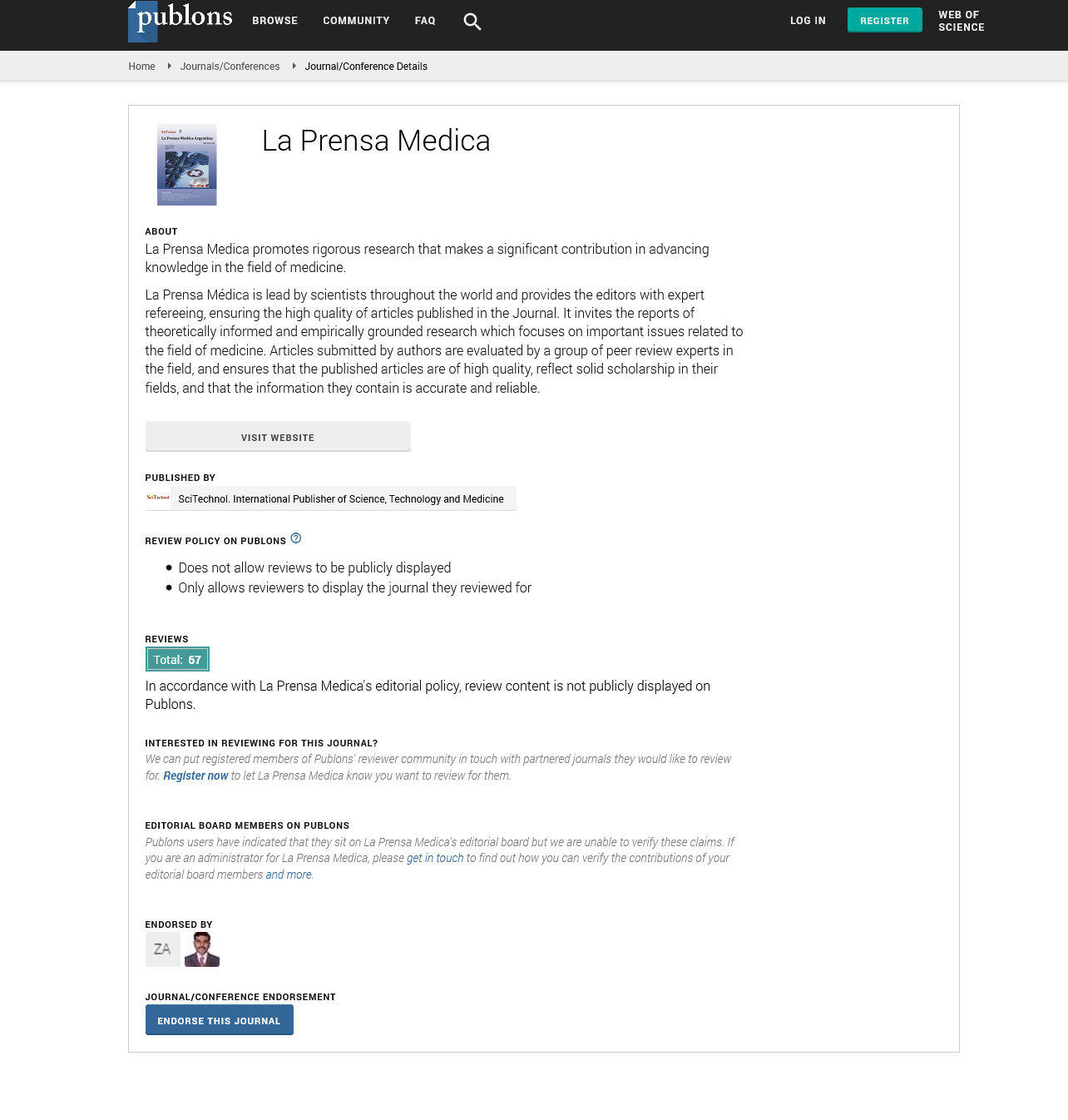Opinion Article, La Prensa Medica Vol: 109 Issue: 3
Exploring the Promise of CRISPR Technology in Genetics and Healthcare
Rebeca Dominguez*
Department of Health Psychology, University of Alicante, Alicante, Spain
*Corresponding Author: Rebeca Dominguez
Department of Health Psychology,University of Alicante, Alicante Spain
E-mail: dominrebeca23madrid@ua.es
Received date: 29 May, 2023, Manuscript No. LPMA-23-107083;
Editor assigned date: 31 May, 2023, PreQC No. LPMA-23-107083 (PQ);
Reviewed date: 15 June, 2023, QC No. LPMA-23-107083;
Revised date: 22 June, 2023, Manuscript No. LPMA-23-107083 (R);
Published date: 29 June, 2023, DOI: 10.4172/0032-745X.1000166
Citation: Dominguez R (2023) Exploring the Promise of CRISPR Technology in Genetics and Healthcare. La Prensa Medica 109:3.
Abstract
Description
The advent of CRISPR-Cas9 technology has revolutionized the field of genetics, offering unprecedented precision and efficiency in genome editing. Clustered Regularly Interspaced Short Palindromic Repeats (CRISPR) and its associated protein Cas9 provide researchers with a versatile toolset to modify genetic material with remarkable accuracy. This article explores the fundamentals of CRISPR technology, its applications in genetic research, and the ethical considerations surrounding genome editing.
Understanding CRISPR-Cas9
CRISPR-Cas9 is a genome editing system inspired by the natural defense mechanism found in bacteria. The CRISPR array consists of repeated DNA sequences separated by unique spacers derived from viral or plasmid DNA. Cas9, an RNA-guided endonuclease, recognizes these spacers and cleaves complementary target DNA. By programming a guide RNA (gRNA) sequence, researchers can direct Cas9 to specific genomic locations for precise DNA modification.
Applications in genetic research
CRISPR-Cas9 has transformed genetic research, enabling scientists to investigate gene function, model diseases, and develop potential therapeutics. It has revolutionized the field of functional genomics by allowing precise gene knockouts or knock-ins in a wide range of organisms, including model organisms like mice, zebrafish, and fruit flies.
One of the key applications of CRISPR technology is in the identification of genes associated with various diseases. By introducing specific mutations in animal models using CRISPR-Cas9, researchers can assess the impact on disease development and progression. This approach has led to significant advancements in understanding of genetic contributions to diseases like cancer, neurodegenerative disorders, and cardiovascular conditions.
Moreover, CRISPR technology has accelerated the discovery of potential therapeutic targets. By selectively disrupting or modifying genes involved in disease pathways, researchers can identify complex molecular players and develop targeted therapies. The ability to precisely edit the genome offers new opportunities for developing personalized medicine approaches, tailoring treatments to an individual's genetic profile.
Therapeutic potential
CRISPR-Cas9 holds immense promise for the development of novel genetic therapies. It offers a potential solution for genetic disorders caused by single gene mutations. By correcting or replacing faulty genes, CRISPR-based therapies aim to treat or even cure previously untreatable conditions.
In the field of inherited genetic disorders, CRISPR technology provides a means to directly repair disease-causing mutations. It allows for precise modifications at the DNA level, targeting specific mutations and restoring normal gene function. Promising preclinical and early clinical trials demonstrate the potential of CRISPR-based approaches in treating diseases such as sickle cell anaemia, beta-thalassemia, and muscular dystrophy.
CRISPR-Cas9 is also being explored for its potential in cancer treatment. By targeting cancer-related genes, researchers can disrupt the mechanisms that promote tumor growth or enhance the immune system's ability to recognize and eliminate cancer cells. While challenges remain, including efficient delivery of CRISPR components to target cells and potential off-target effects, ongoing research is focused on optimizing these aspects to harness the full therapeutic potential of CRISPR-based approaches.
Advancements and challenges
Advancements in CRISPR technology continue to refine and expand its applications. Researchers are exploring modifications to Cas9, such as high-fidelity variants, to enhance specificity and reduce off-target effects. Base editors, which allow precise single-base changes without cutting the DNA, provide additional flexibility in modifying the genome.
Efforts are also underway to optimize delivery methods for CRISPR components. Viral vectors, such as Adeno-Associated Viruses (AAVs), and lipid nanoparticles are being utilized to efficiently transport the CRISPR-Cas9 system into target cells. These delivery systems need to balance effectiveness, safety, and scalability for potential clinical applications.
While CRISPR technology offers tremendous potential, challenges and ethical considerations accompany its use. Off-target effects, where Cas9 may inadvertently edit unintended genomic sites, need to be minimized to ensure accurate and safe genome editing. Furthermore, the ethical implications of germline editing, modifying the genetic material passed on to future generations, raise significant concerns and require careful evaluation and discussion within the scientific and broader communities.
Ethical considerations
The unprecedented power of CRISPR-Cas9 raises significant ethical considerations. The ability to edit the human germline, potentially altering the genetic makeup of future generations, raises concerns about unintended consequences and the potential for misuse. The scientific community and regulatory bodies are engaged in ongoing discussions to establish guidelines and ethical frameworks for responsible use of CRISPR technology, emphasizing transparency, safety, and public involvement in decision-making processes.
Conclusion
CRISPR-Cas9 technology has revolutionized genetic research, offering new avenues for understanding gene function, disease mechanisms, and potential therapeutic interventions. While the field continues to advance rapidly, ethical considerations surrounding genome editing must be addressed to ensure responsible and beneficial use of this powerful technology.
 Spanish
Spanish  Chinese
Chinese  Russian
Russian  German
German  French
French  Japanese
Japanese  Portuguese
Portuguese  Hindi
Hindi 

